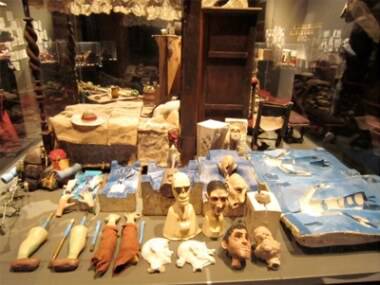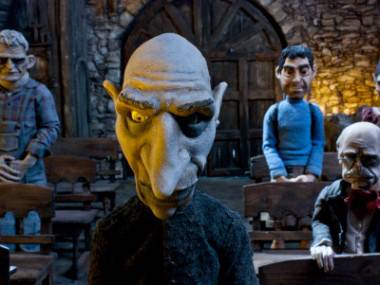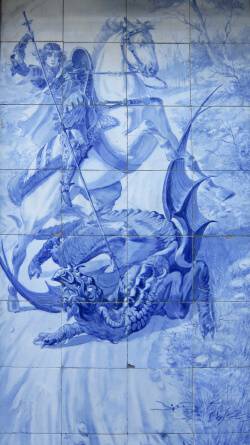MONSTRA 2013 Overview
MONSTRA is Lisbon’s international animation festival that takes place every year in March. Its focus is to showcase the best animation from all over the world and to create a dialogue between artists and curious film fans alike. From a freelance animator’s perspective it serves as a great opportunity to get to know new filmmakers in person as well as on screen and to explore the colourful capital of Portugal.
 As the festival is known for its diversity, the programme is made up not just of screenings but workshops, masterclasses and exhibitions that take place in several cinemas, theaters and museums across the city. This year for ten days MONSTRA welcomed Spain and Brazil as its guest countries by giving their films and filmmakers a spotlight in the programme. Memorable in this context was the temporary stop motion exhibition in Lisbon’s Puppet Museum, which displayed the amazing art and craft work of I+G Stop Motion Studio from Barcelona. Behind this name are the award-winning directors Anna Solanas and Marc Riba as well as newcomer Fernando Cortizo who successfully screened his new and very first European stereoscopic stop motion film O Apóstolo (The Apostle) in MONSTRA’s Feature Length Competition.
As the festival is known for its diversity, the programme is made up not just of screenings but workshops, masterclasses and exhibitions that take place in several cinemas, theaters and museums across the city. This year for ten days MONSTRA welcomed Spain and Brazil as its guest countries by giving their films and filmmakers a spotlight in the programme. Memorable in this context was the temporary stop motion exhibition in Lisbon’s Puppet Museum, which displayed the amazing art and craft work of I+G Stop Motion Studio from Barcelona. Behind this name are the award-winning directors Anna Solanas and Marc Riba as well as newcomer Fernando Cortizo who successfully screened his new and very first European stereoscopic stop motion film O Apóstolo (The Apostle) in MONSTRA’s Feature Length Competition.
 After watching, visitors were given the interesting opportunity to see the puppets and sets displayed in a dimly lit room, capturing the dark mood of the stop motion. The film is set in Spain’s past, bringing to life the time of traditional myths and stories of the pilgrimage to Santiago de Compostela. Compared to Tim Burton’s style this felt more historic and real, possible reasons for which being the natural colour palette, human body proportions as well as the rich and very detailed sets. Surprisingly the size of the built environment and puppets were smaller than imagined.
After watching, visitors were given the interesting opportunity to see the puppets and sets displayed in a dimly lit room, capturing the dark mood of the stop motion. The film is set in Spain’s past, bringing to life the time of traditional myths and stories of the pilgrimage to Santiago de Compostela. Compared to Tim Burton’s style this felt more historic and real, possible reasons for which being the natural colour palette, human body proportions as well as the rich and very detailed sets. Surprisingly the size of the built environment and puppets were smaller than imagined.
Feature Length Competition
The selection for the feature length competition provided an incredible variety in terms of animation technique, genre as well as target audience and age. It seemed like a multicultural pot of soup created with any ingredient one could find; The sweet flavour of a 2D hand drawn nostalgic drama romance From up on Poppy Hill next to a savoury taste of humorous pirate clay adventure Selkirk, the Real Robinson Crusoe. Also added were children’s fantasy adventures (Lotte and the Moonstone Secret, Kirikou et les Hommes et les Femmes) as well as the modern fairy tale Fimfarum, the Third Time Lucky and youth fantasy films Le Tableau and A Letter to Momo. Festivalgoers revisited the infamous A Cat in Paris and discovered Approved for Adoption, a new French-Belgian animated graphic novel adaptation that tells the story of a Korean boy growing up in a Belgian family and his problematic childhood. The style is an attractive mix of 2D hand drawn, CG and even live-action.
The overall taste of the film selection was spicy in the right way, with a memorable aftertaste, serving as a good reflection of the high standard produced in the animation world without the huge market leaders. Particular mention goes to the visually colourful Le Tableau, a film is set in an artist’s painting where the characters raise questions about why their environment was never completed by the artist. The style of the film is an homage to artists from the late 19th century onwards.
Portuguese shorts sponsored by SPA – Portuguese Author Society
Absorbing the short film competition compiled by the Portuguese Author Society made for an interesting selection as the films, all completed in 2012, discussed Portuguese culture, history and modern life, without being overtly political. Any Other Man by Luis Soares stood out as particularly enjoyable, showing a man sitting in a cafe window every day after work, smoking a cigarette and observing life happening around him; As the audience you feel you are part of this observational process, you become the observer. The hand drawn style resembles Sylvain Chomet’s work.
There was undeniably some humour missing in this film selection, though this seemed intentional as from other screenings it’s clear that Portuguese don’t only produce serious films.
Student short competition
An important aspect of the festival is the student short film competition that awards national and international animations by emerging talent. It is presided over by both a junior and senior jury. As with all screenings of student shorts there are films that…
really hit you (Oh Sheep!),
play with your patience (QQQ),
just entertain you (Bier im Tier, A la Francaise, Stewpot Rhapsody)
disturb you (Fly Mill),
are so cute you want to eat them (The Little Bird and the Leaf)
stick to your heart (Leontine)
make you relax (Snail Trail)
make you want to shake your body (Corpo Body Corps Körper Corpus)
make you think (It Is What It Is)
and are great book adaptations (Branco).
Those events and emotions are only a briefly captured example of what is likely to happen watching five ninety-minute blocks of student shorts, with a sobering gamut of films produced by one person in a bedroom alongside films that simulated studio working conditions involving a whole team. All of these generated their own charm leaving it to their audience to give comments.
Gottfried Mentor’s standout CG short Oh Sheep! depicts the meeting of shepherds with identical looking flock of sheep that immediately mix together happily, this companionship unwanted by either of the shepherds who try to keep the groups separate from each other. This slightly ghoulish film was highly appreciated at MONSTRA wining three awards.
The Grand Prix MONSTRA went to the Romanian animated documentary Crulic – The Path to Beyond. With a compelling style that combined hand drawn, cut out, collage and stop motion, the film tells the life story of a 33-year old man who died in a Polish prison on a hunger strike.
Audience members, festival staff and filmmakers convened each evening at Cinema São Jorge bar. On one such evening Fernando Galrito, the art director of the festival, divulged the saga of the origin of the festival’s name:
 How MONSTRA got its name
How MONSTRA got its name
The name MONSTRA is related to its main host cinema São Jorge in Lisbon after the saga of Saint George, who defeated what is known to be a female dragon. The festival’s title derives from this female version of a monster which is indicated through the letter “a” at the end. As Portuguese nouns have a gender and the regular word for monster is male the festival’s title creates a female version of it.
Animation itself is about storytelling and the title links to the story of São Jorge which can even be found on Lisbon’s house walls.

